|
12.5"
NGT Telescope
|
NGT-12.5
12.5" Split-Ring Newtonian
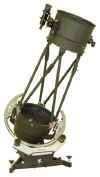
NGT12.5
$5,795
* |
|
|
NGT-12.5 Product Information
DISCONTINUED
Features
• Open truss Newtonian
• Split-ring equatorial mount
• Rotating nose assembly
•
Built-in azimuth adjusting plate
for easier polar alignment
• Compact size
• Fast one-man assembly
•
Removable ring assembly
allows greater disassembly with the largest component weighing 40 lb.
•
Sidereal, Lunar, Solar and King
tracking rates with both
Northern and Southern hemisphere operation
•
Dual control drive corrector
with 0.3x / 0.5x / 2x / 4x / 8x / 16x correction
•
NGC-microMAX Computer digital
setting circles
• CCD autoguider compatible
•
AC and DC power (see below)
• Adjustable focal point
• Snap-fit Serrurier truss rods
• JMI's celebrated quality
construction
Specifications
Type: Newtonian
reflector
Mount: Equatorial split-ring
Mirror: 12.5" f/4.5 Nova Optical Systems 2" thick Pyrex
diffraction-limited enhanced primary (96%
reflectivity), 2.6" diagonal enhanced secondary
Power: 12vDC operation with included AC and DC adapters (see below)
Weight: approximately 120 lb., the heaviest single component is 40
lb.
Height: 64" assembled, 31" collapsed, Eyepiece height
59" at Zenith
Width: 26"
Depth: 29"
Finder: 9x50 straight through
Standard Equipment
Rotating Nose Assembly
for comfortable viewing of any part of the sky.
EV-2n Focuser. (upgrades available)
Extension Tube for 2" Focuser.
25mm 1.25" Plössl Eyepiece.
9x50 Finder Scope (straight-through) with dovetail mount.
Piggy-Back Camera Mount for piggy-back photography.
Off-Axis Counterweight for attaching to the piggy-back camera mount
(2).
Serrurier Truss Rods snap fit into heat treated, spring steel cavities.
Adjustable Focal Point including three different nose assembly mounting
positions for visual and photographic work.
Sliding Counterweights positioned along the truss rods for fine tuning
the balance (3).
Split-Ring Equatorial Drive with 26" drive ring.
3-Point Large-Cup Flotation Mirror Cell.
Primary Mirror Dust Cover.
Integrated Optical Encoders for use with a "MAX" computer.
NGC-microMAX Computer digital setting circles with a 245-object
database. (upgrades
available)
Drive Corrector with dual axis control, 0.3x / 0.5x / 2x / 4x / 8x /
16x correction, North/south hemisphere operation and CCD autoguider interface
(see warning).
AC or DC Power with 110vAC/60Hz or 220vAC/50Hz (specify) wall
transformer or 12vDC cigarette lighter adapter.
Built-In Lifting Handle permits easy transportation.
Latitude Adjustment with scale for fine adjustment of latitude
setting. Adjusts from 30º to 58º (optional latitude modifications
are available—see Latitude Modification
below).
Product Manual
See
Document Number 62 in our Document
Library
*
Telescope prices are for the standard telescope configuration. Upgrades
and Options are at additional cost. The listed price also does not
include the crating charge ($225) and any shipping and handling charges.
Please call for a shipping quote.
A
10% DEPOSIT
is required with all telescope orders (5%
IS NON-REFUNDABLE).
Telescopes are custom-built based on the options selected by the
customer and therefore require time to build. The
remaining amount due must be paid before the telescope is
shipped.
The Telescope ships in a crate approximately
34" x 34" x 37".
|
|
|
|
12.5"
NGT Optional Upgrades
|
EV-1nM
Focuser Upgrade
Add a Motor, Dual Speed Knobs and a Dial Indicator

EV1NMupg
$250
|
EV-1n
Focuser Upgrade
Add Dual Speed Knobs and a Dial Indicator

EV1Nupg
$90
|
EV-2nM
Focuser Upgrade
Add a Motor

EV2NMupg
$160
|
|
|
Upgrade the EV Focuser
This option upgrades the focuser from the
EV-2 model without motor (EV-2n) to the EV-2
model with motor (EV-2nM) or the EV-1 model
with or without the motor (EV-1nM or EV-1n).
The EV-1 includes Dual Speed Knobs and a Dial Positioning Indicator.
EV-1n focuser with
motor, Part Number EV1NMupg
EV-1n focuser without motor, Part Number EV1Nupg
EV-2n focuser with motor, Part Number EV2NMupg
|
|
|
Next
Generation Computer
Upgrade the
NGC-microMAX to an NGC-superMAX Computer
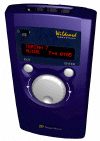
SUPMAXupg
$360
|
Next
Generation Computer
Upgrade the
NGC-microMAX to an NGC-MAX Computer

NGCMAXupg
$260
|
|
|
Upgrade Next Generation Computer
Compare Next
Generation Computers (NGC) in our Computer
Comparison Chart. These computers can be used as stand-alone computers
or they can interface with a personal computer (PC). Either way they will
guide you in finding objects in the night sky.
NGC-superMAX
upgrade, Part Number SUPMAXupg
NGC-MAX
upgrade, Part Number NGCMAXupg
|
|
|
Software
Guided Telescope
(SGT-MAX) Upgrade
(PC Version)
Serial Interface Cable for the
NGC-MAX
(for either PC or Standalone Operation)

CBLBBOX
$49
|
Software Guided Telescope
(SGT-MAX) Upgrade
(PC Version)
B-BOX Interface
(for PC Operation Only)
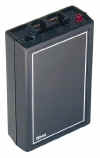
SGTMAXupg
$50
|
|
|
Convert to a Software Guided Telescope
System (SGT-MAX Computer)
Create a real-time link with a PC using
planetarium software (not included).
The interface can be accomplished with either the NGC-MAX
(see above) and the Serial
Interface Cable (left)
or a BBOX (left),
the Serial Interface Cable (included with BBOX)
and software (not included, see below).
NGC-MAX Version, Either PC or
Standalone Operation, Part Number CBLBBOX
B-BOX Version, PC Operation Only, Part Number SGTMAXupg
| NOTE |
The B-BOX Serial Interface links the
telescope with a PC running planetarium software. It does not act
as a stand-alone guiding computer.
The Serial Cable (CBLBBOX) will allow the NGC-MAX computer to be used as a
Serial Interface by mimicking the B-BOX Interface.
|
 |
The SGT-MAX system requires PC software
such as TheSky from Software Bisque.
This is a sample screen image of TheSky. |
|
|
|
F-Stop
Add a 4" F-stop Opening in the Mirror Dust Cover

NGTFSTOP12
$69
|
|
Add an F-Stop to the Primary Mirror Dust
Cover providing a 4" aperture.
(At the time of
purchase only.) |
|
|
Latitude
Modification
For Low or High Latitudes

NGTLMOD12
$225
|
|
|
Latitude Modification
for low or high latitudes.
The normal latitude range of the NGT-12.5 (30º to 58º)
can be adjusted with modifications to the base of the telescope. These modifications
are only available with a new telescope order. The telescope cannot be upgraded
after purchase. Call for specific details.
|
|
|
|
12.5"
NGT Optional Accessories
|
Light Baffle
Nose Extension

NGTBAF12
$90
|
|
|
Light Baffle
nose extension
Prevents stray light from entering into the focuser.
|
|
|
Telrad Finder

TELRAD
$47
|
|
|
|
Telrad Finder Mounting Adapter

BRKTTELRAD
$35
|
|
|
Telrad Finder Mounting Adapter |
|
|
Extra Sliding
Truss-Rod Counterweight
(Each)
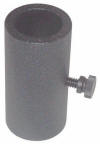
CWTR
$35
|
|
| Extra Sliding Truss Rod Counterweight (each) |
|
|
Truss-Rod
Light Shroud
Light-Weight Black Fabric

NGTSHRD12
$95
|
|
|
Truss Rod Shroud
Blocks stray light and air currents and helps keep dust off
of the mirrors. Made of light-weight black fabric with securing snaps and elastic at
both ends.
|
|
|
Extra Center Counterweight
Offset Heavy Equipment

CWCCD12
$50
|
|
|
Extra Center Counterweight
A 4.3 lb Counterweight that screws into the bottom center
of the mirror tub and offsets the weight of a CCD camera or other heavy
equipment.
 |
Bottom View
of Counterweight |
|
|
|
Handlebar and
Wheels
Move Fully-Assembled Telescope
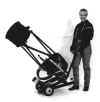
NGTWHL12
$149
|
|
|
Handlebar and Wheels
For easily moving the fully-assembled telescope over most
surfaces. Uses 8" solid rubber ball bearing wheels.
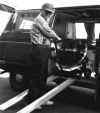 |
The
NGT-12.5's Handlebar and Wheels option gives easy wheelbarrow-style
transportation. Harold Harris (Alamosa, Colorado) easily loads his new NGT-12.5 into his van. |
|
|
|
 |
The
NGT-12.5 telescope. |
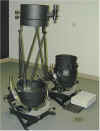 |
This
images shows two NGT-12.5 telescopes side by side, one assembled and the
other collapsed for transporting or storage. |
 |
The
NGT-12.5 is a smaller version of the original NGT-18. |
 |
The 12.5 can
be further disassembled by removing the mirror cell assembly. |
 |
All drive
motor gears have a certain amount of slop. To eliminate gear slop,
the NGT-12.5 uses a two motor drive system. The purpose of the
second motor is to hold tension on the gears. Once in a while you
will need to "rack" the second motor to reestablish the
tension. This is done by pressing the right directional key while
holding the motor switch on. This switch, which can be found on the
bottom of the motor housing, stops the second motor, thus creating the
tension. |
 |
The nose
assembly is removed from the top ends of the truss rods by supporting it
with the arm while removing the thumbscrews. |
 |
The nose
assembly is installed in the same manner, by supporting it with the arm
while attaching the top ends of the truss rods with thumbscrews. |
 |
The ball ends
of the truss rods are easily removed by slightly pressing on the spring
clips while forcing the rods down toward the center of the tub (see inset
photo). Placing a couple of fingers between a pair of rods
allows for removal of both at the same time without scratching the
paint. Most of the work should be done by leveraging the rods inward
against the back of the spring clips rather than prying the spring clips
open. |
 |
When
reassembling, the ball end of a truss rod is inserted into the matching
spring clip by holding the opposing side of the tub with the knee (to keep
it from rocking), slightly opening the spring clip, then pressing the rod
straight into the clip by pushing down on the top end of the rod. |
 |
The ring and
tub assembly can now be removed from the base. First, unscrew the
quick-release knob at the south bearing as shown. Next, disconnect
the declination encoder and drive motor cable. Finally, lift the
ring and tub assembly off the base. |
 |
After
disassembly, the telescope can be easily transported piece by
piece. If the mirror cell is removed, the heaviest single
component (the ring and tub assembly) is approximately 40 pounds. |
 |
"[I put] a
hole in my deck. The [NGT-12.5] telescope sits on a dedicated column
separate from the deck. When I am not using the telescope, the top
half of the scope comes off and an enclosure with a coffee table top
protects the scope. You can see the enclosure off to the side of the
telescope in the attached picture. It works great." (Customer
Skip Gjersdal, 2013) |
What is a
Next Generation Telescope?
The Next Generation
Telescope (NGT) is a uniquely designed equatorial Newtonian. It
features a low profile, split-ring equatorial drive, open Serrurier truss
rod design, rotating nose assembly, compact size, JMI's celebrated quality
construction and now a Go-To computer (NGT-18 Model). The NGT is a revolutionary
instrument that has won awards and acclaim throughout the world. It
is available in 12.5" (f/4.5) and 18" (f/4.2 or f/4.5) apertures. |
What is an
Ampere-Hour?
The Ampere (amp) is a unit of measure of
electrical current (or flow). Batteries are often measured in ampere-hours to show
the total electrical current capacity. For instance, a fully charged
seven amp-hr battery will supply one amp of current at a particular
voltage for approximately seven hours before it is fully discharged (1
amp x 7 hours = 7 amp-hr). If, instead, the battery is drained
continuously at seven amps, it will discharge in approximately one hour (7 amps x 1 hour = 7 amp-hr).
This formula is only approximate because of many factors that effect the
battery including construction, temperature, speed of discharge and
variations in voltage.
|
Customer
Comments
"The scope works
very well. I had it out the other night and was using my Denk II
binoviewers on the Moon and it tracked at the Lunar rate flawlessly for
over two hours (using eyeball polar alignment as described in the
manual)!" (R. F. W.)
"On reassembling the [NGT-12.5]
telescope I was once again amazed at how well it holds
collimation." (L. S.)
"Do I like your NGT? Oh yeah, 11
years old and going strong. On a night of good seeing with
collimation tweaked to the max, it can blow your mind." (J. M.)
"WOW -- I LIKE THE [NGT-12.5] SCOPE --
IT WORKS. ... Really a very well designed scope. The
rotating collar works better than I thought it would and the
counterbalancing is a snap. The height angles for the eyepiece are
proper and of course the optics are right on. The colors are
remarkable. I guess even in a MAK, the colors get lost. This
is great. ... Thank for making such a good
product." (R. H.)
"I want to let you
know that we have enjoyed using the NGT-12.5 scope that we purchased from
you several years ago. The scope has proven to be extremely easy to
wheel out and set up and operate outside the center. It is truly a
general purpose scope providing wide views of low power, but also standing
up to high magnifications of 205 - 410x when seeing conditions support
it. This latter feature was unexpected when I selected the NGT-12.5
and is a testimony to the excellent optics that you have selected.
High magnification views of M13 are breathtaking. The separation of
components of the double-double puts many expensive refractors of smaller
aperture to shame, and transits of Io are easy to spot even when you're
not expecting them. I've been meaning to share my overall
satisfaction with the NGT-12.5 with you for some time, and this occasion
provided the opportunity." (J. M.)
The following comments
were re-written from a very broken English: "I have a JMI NGT-12.5
telescope which I purchased in August of 2001 in Japan. The NGT-12.5
is the most wonderful telescope that I have ever used. I have been
accepted for publication in the Japanese monthly astronomical magazine 'Tenmon
Guide' with my JMI NGT-12.5 and SBIG ST-8e.... (I'm sorry, I can't
speak and write English. I used a Japanese-English dictionary to
write this email.) I want to introduce the NGT-12.5 to more and more
Astronomers in the World!!!!!" (J. M.)
"The JMI NGT-12.5
is probably the best scope I have ever owned. Its workmanship is a
masterpiece and the optics are as good or better than the four scopes with
Zambuto optics in them. They are the equal of my 15" Obsession,
10" and 17.5" Discovery and 12.5" Portaball. It
tracks excellently and is the showcase of most of the star parties I
attend. You could not go wrong purchasing one of these fine
telescopes." (Craig Woodley)
"...my NGT-12.5 is still doing
fantastic. I've now torture tested it at -25 degrees C and had no problems
(although I had to wear battery socks and mitts at that observing session)."
(W. F.)
"My initial reaction is, 'What a
superb telescope!'" ... The construction of the scope is impressive. I had seen
the ads for this scope over the past couple of years and read a glowing set of comments in
'Star Ware' about the engineering. Seeing it in person and now understanding the
construction a little better, I am very impressed. This should be the last telescope
I will ever feel compelled to own. What I like best is how compact it is
—
it goes straight out the door from the living room to the deck with none of the
inconvenience I experience in setting up and tearing down the SC. ...There is no
question that the optics are superior to anything I have used before. ...I have absolutely
no buyer's remorse on this purchase. It is an excellent, exciting telescope and has
renewed my passion for astronomy..." (B. G. M.)
"I am loving my NGT-12.5 that I
bought from JMI last fall. What a wonderful scope! Since receiving the scope
last October I have nearly finished off the Messier objects and the RASC finest 110 NGCs
with this scope and can't believe how good the scope stays in collimation (I must have set
up and taken the scope down about 20 times without having to
collimate) ... It sure is nice to know there is someone there that I can
email for technical support who knows their stuff. Too many places have too little
support once they sell their item, and I'm glad JMI isn't one of them!"
(W. F.)
"I must tell you, this is a
wonderfully designed telescope. Assembly is quick and simple, and the largest
section weighs less than my LX200 8". Optically the 12.5 is unbelievable, with
galaxies just floating in deep rich dark star fields. ... WOW! I ... have checked
and tested the [periodic error] which I found does not exist on the NGT-12.5.
...several people in my area have shown [an] interest and ... looking through an eyepiece
will turn their heads every time. Great work!" (J. D.)
"The NGT-12.5 arrived!
...you have really been right with all you told me! Excellent craftsmanship
and quality wherever I look. A perfect mirror, solid and strong material for the
scope, everything fits snugly at the first try. That's what I really call good
work! ...a big Thank You..." (R. K.) |
|
Frequently Asked Questions
(FAQ)
|
| Q. |
How long
does it take to set up an NGT-12.5? |
| A. |
After a little
practice, the NGT-12.5 can be routinely assembled in less than five minutes. |
| |
|
| Q. |
Does the
rotating nose assembly make collimation difficult or impossible? |
| A. |
Contrary to
erroneous reports on the Internet—No. Here are some comments from Tom Johnston
who builds the NGT-12.5 telescope:
"Not only do
I build the NGT-12.5 here at JMI but I also own one. I use it primarily to monitor
faint periodic comets (using an ST7) for the IAU.
"There is a very simple pro and con relationship with
the rotating nose on the NGT. This ability to place the eyepiece at a variety of
comfortable positions in an enormous factor. The ease of use really cannot be
realized until you've spent a night observing with it. In addition, the rotating
nose allows you to place a heavy CCD camera in a more balanced and less stress producing
position above the tube instead of hanging off the side. I personally would not give
up my rotating nose.
"Here is the flip side. It is difficult to
collimate IF you have never done it before because it requires that you find the best
possible collimation position relative to the entire rotation of the nose. After
you've done it a few times, it's easy.
"Before the scope leaves JMI, a laser spot must stay
within the small white circle placed at the center of the primary mirror, throughout the
360 degrees of rotation of the nose. The spot may dance around a little bit inside
the circle but it remains INSIDE. Using a Cheshire eyepiece, we then adjust the
primary slightly until it is as close as it can get for the entire rotation. There
may be a few places in the circle where the Cheshire indicator is not perfect...but it
will be off only slightly. It's something you do not easily see visually or in a CCD
image...but people like to talk about it anyway. The only problems I have heard of
are when people try to collimate it like a normal (non-rotating) Newtonian." |
| |
|
| Q. |
Does the NGT
hold collimation? |
| A. |
We have found that
this telescope stays in collimation much longer than the average Newtonian. Most
Newtonian reflectors need to be collimated every other time they are used. A recent
floor model NGT-12.5 remained collimated over a span of at least 15 sessions. These
sessions included two trips to major star parties (RTMC and Okie-Tex) and periodic comet
observations and imaging in the mountains of both Colorado and Arizona. |
| |
|
| Q. |
How do you
polar align the telescope? |
| A. |
There is a latitude adjustment screw that runs down the center of the
telescope base. The screw is parallel to the polar axis and can be
visually pointed at the celestial pole. This process can get you to
within one-half degree of polar alignment in only seconds and, of course, you can use the good old stardrift
method (see Document no. 8 in our Document
Library). |
| |
|
| Q. |
Can the NGT
be leveled? |
| A. |
All NGT equatorials
have leveling screws and a bubble level located on the base. |
| |
|
| Q. |
How does dew
affect the telescope? |
| A. |
All components of
this telescope are rust proof. Water on the drive ring has no affect on the
tracking. |
| |
|
| Q. |
How accurate
is the split-ring drive? |
| A. |
Split-ring drives
have little or no periodic error. In a random test of a polar aligned NGT-12.5, it
held the Dumbbell Nebula in a 30 arc minute field of view for over an hour.
Autoguiding feedback data from an SBIG ST7 CCD camera has confirmed this precision. |
| |
|
| Q. |
How does the
wind affect the NGT? |
| A. |
All truss tube
Newtonian telescopes that use a shroud are subject to windy conditions. Sudden wind
gusts are more of a problem than sustained winds when imaging with a CCD camera.
However, we believe that this telescope is not affected by wind any more than a standard
German Equatorial Newtonian telescope. Tom Johnston, Production Manager and NGT-12.5
assembler, routinely uses production scopes (as part of JMI's Quality Control process) for
gathering CCD images of periodic comets. He reports very good results in moderate
wind. |
| |
|
| Q. |
Can the
telescope be controlled by an autoguider? |
| A. |
With the proper
cables and relay box (if needed) any autoguider can control an NGT-12.5 or NGT-18
telescope. |
|